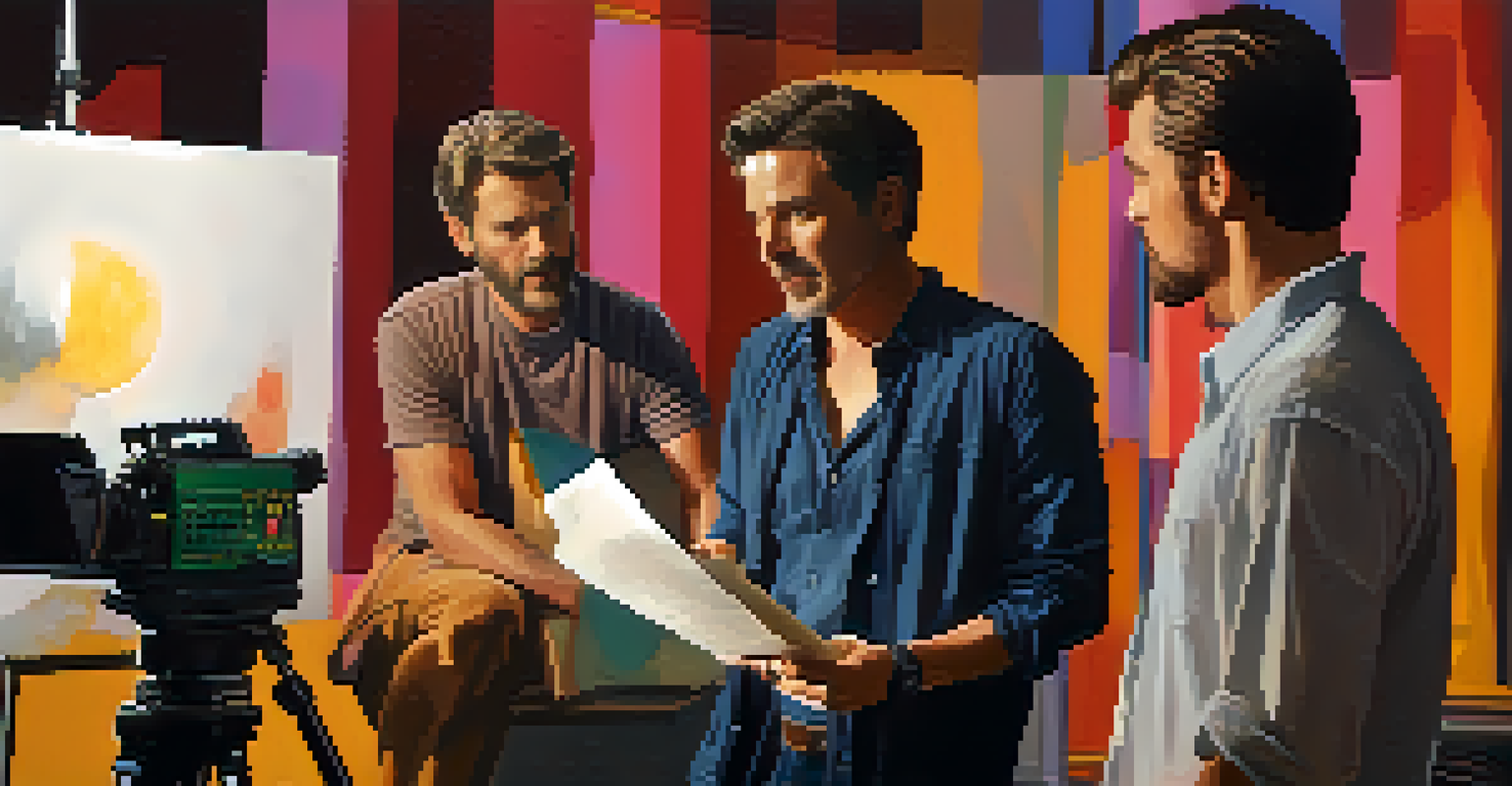The Role of Directors in Shaping Literary Adaptations

Understanding the Director's Vision in Adaptations
Directors play a pivotal role in bringing literary works to life on the screen. Their unique vision determines not only how the story is told but also how characters are portrayed. For instance, a director might choose to emphasize specific themes that resonate with contemporary audiences, thus shaping the adaptation to fit modern sensibilities.
A film is a petrified fountain of thought, and it is the director who breathes life into it.
The director’s interpretation can breathe new life into a classic story, making it accessible and relatable. By focusing on certain elements, they can draw out deeper meanings that may not have been as evident in the original text. This approach can lead to a richer cinematic experience for viewers, who may find themselves connecting with the narrative on a personal level.
Ultimately, the director's vision is crucial as it sets the tone and pacing of the adaptation. This creative direction influences everything from casting choices to cinematography, ultimately shaping the audience's overall experience of the film.
Adapting Literary Themes for the Screen
Literary adaptations often involve the challenge of translating complex themes into a visual format. Directors must decide how to convey these themes without losing the essence of the original work. For example, a director might choose to focus on visual symbolism to represent a story’s deeper meanings, making the themes more accessible to viewers.

This transformation requires a balance between fidelity to the source material and creative interpretation. A director might incorporate modern elements or visual metaphors to reflect contemporary issues, thus making the story relevant to today’s audience. This can lead to a fresh take on the narrative, inviting viewers to engage with it in new ways.
Director's Vision Shapes Adaptations
A director's unique interpretation influences how stories are told and characters are portrayed, making adaptations relatable to modern audiences.
Through thoughtful adaptation, directors can highlight the universal themes of a literary work, showing how they resonate across different eras. This not only enriches the audience's understanding but also invites discussion about the relevance of these themes in today’s world.
Character Development in Literary Adaptations
One of the significant aspects of a director's role is character development. In adaptations, there may be a need to alter or expand characters to fit the cinematic format. Directors can delve into a character's motivations, providing depth that might not be fully explored in the original text, thus enhancing audience connection.
Adaptation is about the way we interpret the world. It’s about finding that thread that connects us to the original narrative while weaving in our own unique perspective.
For instance, a director might choose to include flashbacks or additional scenes that provide context to a character’s actions. This backstory can create a more nuanced portrayal, allowing audiences to empathize with characters on a deeper level. Such decisions significantly impact how viewers perceive and relate to the characters throughout the film.
By focusing on character arcs, directors can also ensure that the emotional journey aligns with the narrative's themes. This careful crafting of characters can lead to a more engaging and memorable cinematic experience, encouraging audiences to reflect on their own lives and choices.
Balancing Fidelity and Creative Freedom
Directors often face the challenge of balancing fidelity to the source material with their own creative freedom. While staying true to the original story is important, adapting a literary work also allows room for innovation. A successful adaptation often finds this balance, offering a fresh perspective while honoring the essence of the book.
For example, some directors choose to make bold changes to plot points or character dynamics, sparking debates among fans of the original work. This can lead to a richer, more complex narrative that invites audiences to reconsider their understanding of the story. However, such changes must be made thoughtfully to avoid alienating loyal fans.
Balancing Fidelity and Innovation
Successful adaptations find a balance between staying true to the original material and incorporating creative freedom to enhance the narrative.
Ultimately, the director's ability to navigate this delicate balance can determine the success of an adaptation. When done right, it can lead to a film that not only pays homage to the source material but also stands on its own as a compelling piece of art.
Visual Storytelling: The Director's Tools
Directors utilize various tools of visual storytelling to enhance literary adaptations. Cinematography, editing, and production design all play crucial roles in translating a written narrative into a visual experience. For example, the choice of color palettes and camera angles can evoke specific emotions that align with the story's tone.
Additionally, sound design and music are vital components that directors use to set the atmosphere. A well-placed score can amplify the emotional weight of a scene, guiding the audience's reactions and deepening their connection to the story. This multi-sensory approach allows directors to create a more immersive experience for viewers.
Incorporating these elements thoughtfully can transform a simple narrative into a powerful emotional journey. Directors who master visual storytelling can elevate literary adaptations, making them memorable and impactful.
Audience Reception and Cultural Context
The role of directors also extends to understanding audience reception and cultural context when adapting literature. A director must consider how different audiences might interpret the story, which can influence their creative choices. This awareness allows them to tailor the adaptation to resonate with viewers from various backgrounds.
For example, adapting a classic novel for a modern audience may require updates to dialogue or character interactions. By acknowledging contemporary cultural norms and values, a director can ensure that the adaptation feels relevant and relatable. This approach can draw in a wider audience, including those who may not have engaged with the original literary work.
Understanding Audience Reception
Directors must consider audience interpretation and cultural context to create adaptations that resonate and engage viewers from diverse backgrounds.
Ultimately, a director's ability to connect the adaptation to its audience can significantly impact its success. By navigating cultural nuances and audience expectations, they can create a film that not only entertains but also sparks meaningful conversations.
The Legacy of Directors in Literary Adaptations
Directors leave a lasting impact on the legacy of literary adaptations, shaping how stories are perceived across generations. Their interpretations can redefine narratives, making them timeless classics in their own right. For example, iconic adaptations often lead to renewed interest in the original literary work, introducing it to new audiences.
As directors continue to explore and reinterpret literature, they contribute to an ongoing dialogue between the written word and cinematic expression. This dynamic relationship encourages both authors and filmmakers to innovate and push boundaries, resulting in exciting new adaptations that challenge traditional storytelling.

In conclusion, the role of directors in literary adaptations is multifaceted and crucial. Their creative vision not only influences the film itself but also affects how literature is celebrated and understood in the cultural landscape.